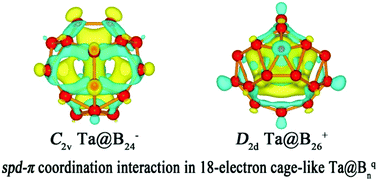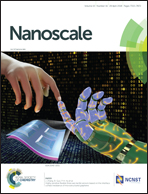Cage-like Ta@B qn complexes (n = 23–28, q = −1–+ 3) in 18-electron configurations with the highest coordination number of twenty-eight†
Abstract
Inspired by recent observations of the highest coordination numbers of CN = 10 in planar wheel-type complexes in D10h Ta@B10− and CN = 20 in double-ring tubular species in D10d Ta@B20− and theoretical prediction of the smallest endohedral metalloborospherene D2 Ta@B22− (1) with CN = 22, we present herein the possibility of larger endohedral metalloborospherenes C2 Ta@B23 (2), C2 Ta@B24+ (3), C2v Ta@B24− (4), C1 Ta@B25 (5), D2d Ta@B26+ (6), C2 Ta@B272+ (7), and C2 Ta@B283+ (8) based on extensive first-principles theory investigations. These cage-like Ta@Bqn complexes with B6 pentagonal or B7 hexagonal pyramids on their surface turn out to be the global minima of the systems with CN = 23, 24, 24, 25, 26, 27, and 28, respectively, unveiling the highest coordination number of CN = 28 in spherical environments known in chemistry. Detailed bonding analyses show that 1–8 as superatoms conform to the 18-electron configuration with a universal σ + π double delocalization bonding pattern. They are effectively stabilized via spd–π coordination interactions between the Ta center and ηn–Bn ligand which match both geometrically and electronically. Such complexes may serve as embryos of novel metal–boride nanomaterials.



 Please wait while we load your content...
Please wait while we load your content...